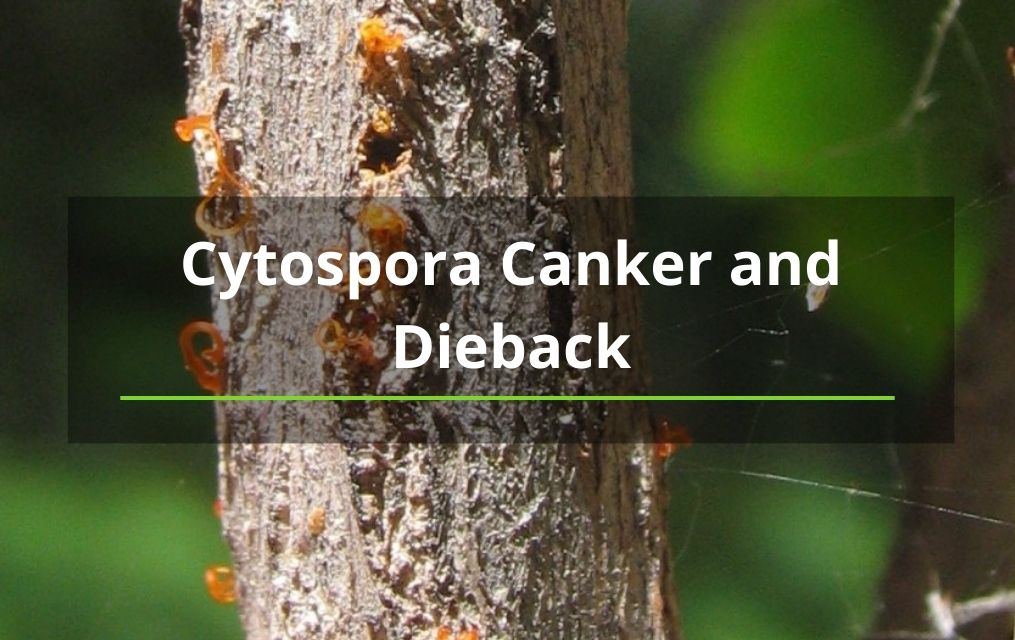Cytospora Canker

Cytospora Canker and Dieback
Oh, the heartbreak of a tree with dying branches! The leaves emerge in the spring, but then by mid-season they wilt, then die, and soon the whole branch is wilted and dead. Depending on the tree species, there might be weird colored goo oozing through the bark, or young dead bark that is spongy-soft instead of hard, dry, and wrinkled, and likely cankers on the branches. What to do about…cytospora fungus?
Cytospora is a genus, meaning a set of distinct but related species sharing a common name (sort of like a family’s last name unites all the individually named family members). There are a lot of species of cytospora, and they tend to be somewhat host specific. This means that the one that attacks peach trees is not quite the same as the one that attacks ash trees, but in general they behave similarly.
The spores of the fungus are air borne; as I was told by a PhD plant pathologist from NMSU, I could scrape the bark on ANY tree in town and they could plate out cytospora from the scrapings. This means that the potential for new infection is pretty much everywhere, all the time. New infections start when a spore finds itself on recently exposed wood – like a broken branch, or maybe a pruning wound, or even just branches killed by drought stress symptoms.
Once the spore germinates, the fungus grows in and consumes the plants’ vascular tissues: the phloem and the xylem. Phloem moves the energy made by photosynthesis (in the form of sugars and simple starches) around the plant to wherever energy is needed; that is to say, into every living part of the plant. Xylem, also called sapwood, moves water and nutrients from the soil to the whole plant body, most notably to the leaves. Both tissues also help move plant hormones around, coordinating the various activities of the growing tree. Damage to these tissues is catastrophic for the tree.
In our area, cytospora infections are common on certain species. All of the stone fruit trees (peach, plum, apricot, cherry, nectarine) are quite susceptible. Apple trees can be severely damaged, as can any of the Populus genus – cottonwoods, poplars, and aspens. I’ve had lab samples from an herbicide-damaged ash tree come back positive for cytospora.
As with all plant diseases and pests, healthy trees are often able to withstand the attack of cytospora. Trees that are stressed (by drought, herbicide damage, root damage, over pruning, etc.) have a hard time preventing infection. Sometimes the problem can be fixed by improving the landscape elements to support better tree health, and careful pruning out of the diseased branches. The key to keeping the tree as healthy as possible is in the soil. Good management of irrigation and soil organic matter, as well as surface mulching, makes all the difference to trees. Healthy roots, healthy tree.
There really is no cure for diseased tissues. Severely infected trees should be removed, to limit the local buildup of spores that can start the next round of infections. Soil contamination is not an issue, so a new tree of the same kind could be planted right back into that site. If the environment around the tree hasn’t been improved, though…the new tree may well succumb due to its own stressed vulnerability.
If you suspect cytospora is attacking one of your trees, consider having a sample sent to the plant diagnostic lab at NMSU for testing. Even to seasoned professionals, many diseases don’t look very different from each other. Contact the Bernalillo County Cooperative Extension Service office for details on submitting a sample, or call your trusted tree experts – Legacy Tree Company! Contact us to find out why we are considered the best tree service in Albuquerque.













